Assessment Workbook: CHC50113 Diploma of Early Childhood Education
VerifiedAdded on 2022/09/02
|42
|10528
|24
Homework Assignment
AI Summary
This document is a comprehensive Student Assessment Workbook designed for the CHC50113 Diploma of Early Childhood Education and Care, specifically addressing the unit CHCECE018, which focuses on nurturing creativity in children. The workbook includes a cover sheet, student declaration, and competency judgement sections for the assessor's feedback. It outlines the unit and assessment overview, performance and knowledge evidence requirements, assessment conditions, and topics covered, such as fostering creativity through the physical and human environments, learning frameworks, and providing and evaluating experiences. The assessment tasks involve various questions and activities to demonstrate the candidate's ability to plan and provide creative learning environments, facilitate children's active participation, and understand relevant frameworks. The document also provides information on reasonable adjustments, student support, and the roles of the trainer/assessor. The assessment requires completion of all tasks, with feedback and resubmission opportunities if needed. Additionally, the workbook outlines work placement guidelines, emphasizing the need for 240 hours of supervised placement and supplementary evidence, including a third-party report if working within a childcare facility.
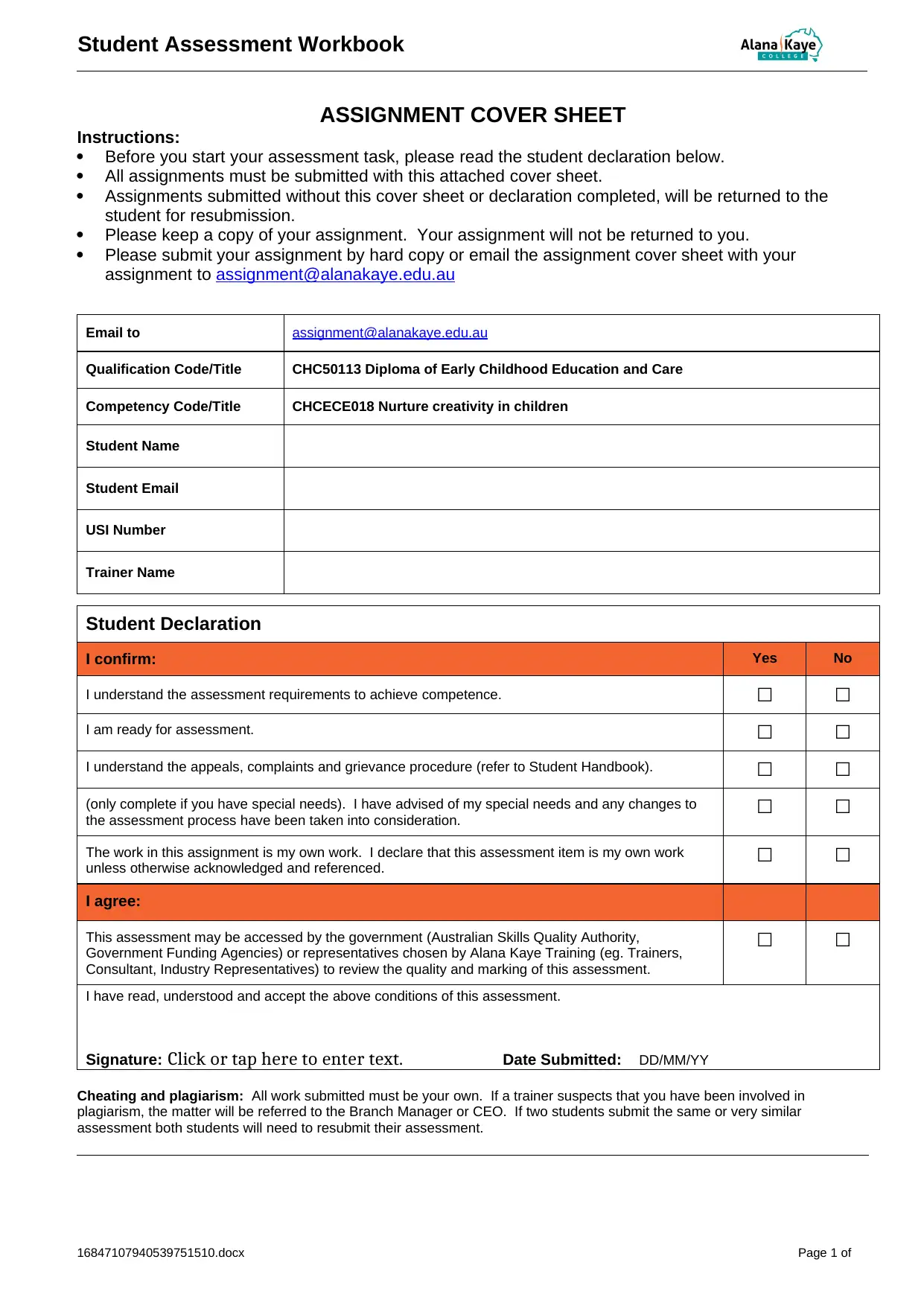
Student Assessment Workbook
ASSIGNMENT COVER SHEET
Instructions:
Before you start your assessment task, please read the student declaration below.
All assignments must be submitted with this attached cover sheet.
Assignments submitted without this cover sheet or declaration completed, will be returned to the
student for resubmission.
Please keep a copy of your assignment. Your assignment will not be returned to you.
Please submit your assignment by hard copy or email the assignment cover sheet with your
assignment to assignment@alanakaye.edu.au
Email to assignment@alanakaye.edu.au
Qualification Code/Title CHC50113 Diploma of Early Childhood Education and Care
Competency Code/Title CHCECE018 Nurture creativity in children
Student Name
Student Email
USI Number
Trainer Name
Student Declaration
I confirm: Yes No
I understand the assessment requirements to achieve competence. ☐ ☐
I am ready for assessment. ☐ ☐
I understand the appeals, complaints and grievance procedure (refer to Student Handbook). ☐ ☐
(only complete if you have special needs). I have advised of my special needs and any changes to
the assessment process have been taken into consideration. ☐ ☐
The work in this assignment is my own work. I declare that this assessment item is my own work
unless otherwise acknowledged and referenced. ☐ ☐
I agree:
This assessment may be accessed by the government (Australian Skills Quality Authority,
Government Funding Agencies) or representatives chosen by Alana Kaye Training (eg. Trainers,
Consultant, Industry Representatives) to review the quality and marking of this assessment.
☐ ☐
I have read, understood and accept the above conditions of this assessment.
Signature: Click or tap here to enter text. Date Submitted: DD/MM/YY
Cheating and plagiarism: All work submitted must be your own. If a trainer suspects that you have been involved in
plagiarism, the matter will be referred to the Branch Manager or CEO. If two students submit the same or very similar
assessment both students will need to resubmit their assessment.
16847107940539751510.docx Page 1 of
ASSIGNMENT COVER SHEET
Instructions:
Before you start your assessment task, please read the student declaration below.
All assignments must be submitted with this attached cover sheet.
Assignments submitted without this cover sheet or declaration completed, will be returned to the
student for resubmission.
Please keep a copy of your assignment. Your assignment will not be returned to you.
Please submit your assignment by hard copy or email the assignment cover sheet with your
assignment to assignment@alanakaye.edu.au
Email to assignment@alanakaye.edu.au
Qualification Code/Title CHC50113 Diploma of Early Childhood Education and Care
Competency Code/Title CHCECE018 Nurture creativity in children
Student Name
Student Email
USI Number
Trainer Name
Student Declaration
I confirm: Yes No
I understand the assessment requirements to achieve competence. ☐ ☐
I am ready for assessment. ☐ ☐
I understand the appeals, complaints and grievance procedure (refer to Student Handbook). ☐ ☐
(only complete if you have special needs). I have advised of my special needs and any changes to
the assessment process have been taken into consideration. ☐ ☐
The work in this assignment is my own work. I declare that this assessment item is my own work
unless otherwise acknowledged and referenced. ☐ ☐
I agree:
This assessment may be accessed by the government (Australian Skills Quality Authority,
Government Funding Agencies) or representatives chosen by Alana Kaye Training (eg. Trainers,
Consultant, Industry Representatives) to review the quality and marking of this assessment.
☐ ☐
I have read, understood and accept the above conditions of this assessment.
Signature: Click or tap here to enter text. Date Submitted: DD/MM/YY
Cheating and plagiarism: All work submitted must be your own. If a trainer suspects that you have been involved in
plagiarism, the matter will be referred to the Branch Manager or CEO. If two students submit the same or very similar
assessment both students will need to resubmit their assessment.
16847107940539751510.docx Page 1 of
Paraphrase This Document
Need a fresh take? Get an instant paraphrase of this document with our AI Paraphraser
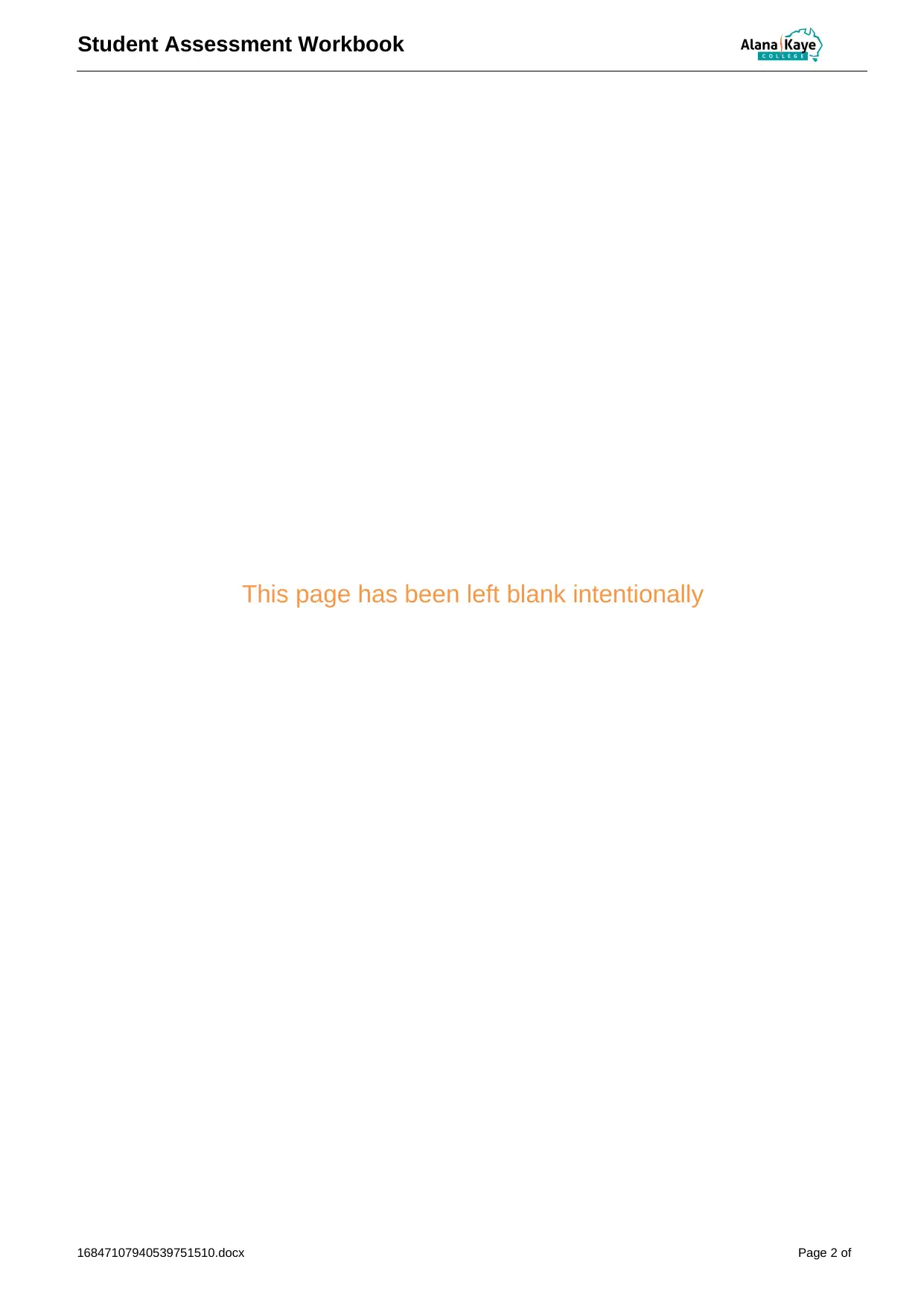
Student Assessment Workbook
This page has been left blank intentionally
16847107940539751510.docx Page 2 of
This page has been left blank intentionally
16847107940539751510.docx Page 2 of
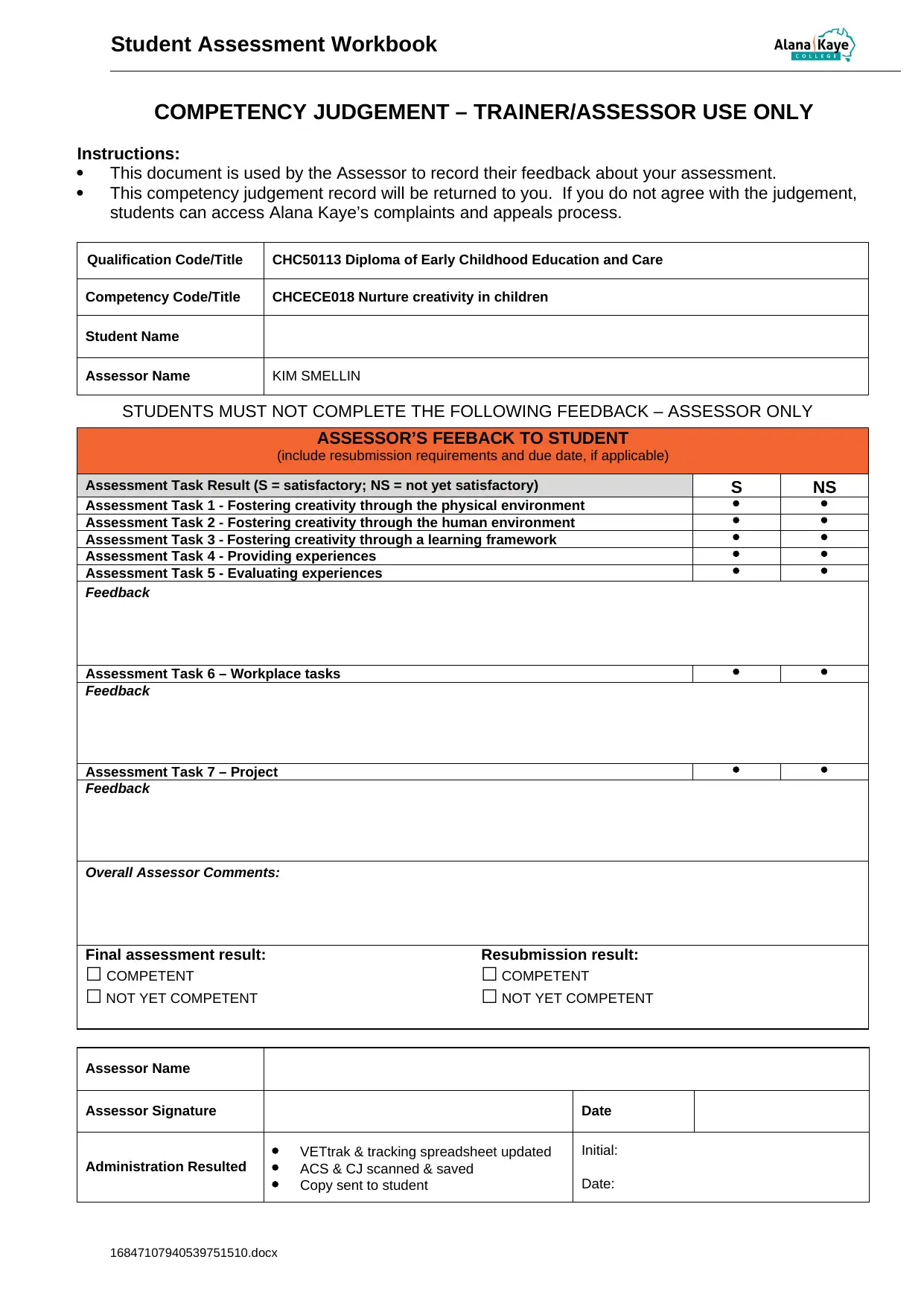
Student Assessment Workbook
COMPETENCY JUDGEMENT – TRAINER/ASSESSOR USE ONLY
Instructions:
This document is used by the Assessor to record their feedback about your assessment.
This competency judgement record will be returned to you. If you do not agree with the judgement,
students can access Alana Kaye’s complaints and appeals process.
Qualification Code/Title CHC50113 Diploma of Early Childhood Education and Care
Competency Code/Title CHCECE018 Nurture creativity in children
Student Name
Assessor Name KIM SMELLIN
STUDENTS MUST NOT COMPLETE THE FOLLOWING FEEDBACK – ASSESSOR ONLY
ASSESSOR’S FEEBACK TO STUDENT
(include resubmission requirements and due date, if applicable)
Assessment Task Result (S = satisfactory; NS = not yet satisfactory) S NS
Assessment Task 1 - Fostering creativity through the physical environment
Assessment Task 2 - Fostering creativity through the human environment
Assessment Task 3 - Fostering creativity through a learning framework
Assessment Task 4 - Providing experiences
Assessment Task 5 - Evaluating experiences
Feedback
Assessment Task 6 – Workplace tasks
Feedback
Assessment Task 7 – Project
Feedback
Overall Assessor Comments:
Final assessment result: Resubmission result:
☐ COMPETENT ☐ COMPETENT
☐ NOT YET COMPETENT ☐ NOT YET COMPETENT
Assessor Name
Assessor Signature Date
Administration Resulted
VETtrak & tracking spreadsheet updated
ACS & CJ scanned & saved
Copy sent to student
Initial:
Date:
16847107940539751510.docx
COMPETENCY JUDGEMENT – TRAINER/ASSESSOR USE ONLY
Instructions:
This document is used by the Assessor to record their feedback about your assessment.
This competency judgement record will be returned to you. If you do not agree with the judgement,
students can access Alana Kaye’s complaints and appeals process.
Qualification Code/Title CHC50113 Diploma of Early Childhood Education and Care
Competency Code/Title CHCECE018 Nurture creativity in children
Student Name
Assessor Name KIM SMELLIN
STUDENTS MUST NOT COMPLETE THE FOLLOWING FEEDBACK – ASSESSOR ONLY
ASSESSOR’S FEEBACK TO STUDENT
(include resubmission requirements and due date, if applicable)
Assessment Task Result (S = satisfactory; NS = not yet satisfactory) S NS
Assessment Task 1 - Fostering creativity through the physical environment
Assessment Task 2 - Fostering creativity through the human environment
Assessment Task 3 - Fostering creativity through a learning framework
Assessment Task 4 - Providing experiences
Assessment Task 5 - Evaluating experiences
Feedback
Assessment Task 6 – Workplace tasks
Feedback
Assessment Task 7 – Project
Feedback
Overall Assessor Comments:
Final assessment result: Resubmission result:
☐ COMPETENT ☐ COMPETENT
☐ NOT YET COMPETENT ☐ NOT YET COMPETENT
Assessor Name
Assessor Signature Date
Administration Resulted
VETtrak & tracking spreadsheet updated
ACS & CJ scanned & saved
Copy sent to student
Initial:
Date:
16847107940539751510.docx
⊘ This is a preview!⊘
Do you want full access?
Subscribe today to unlock all pages.

Trusted by 1+ million students worldwide
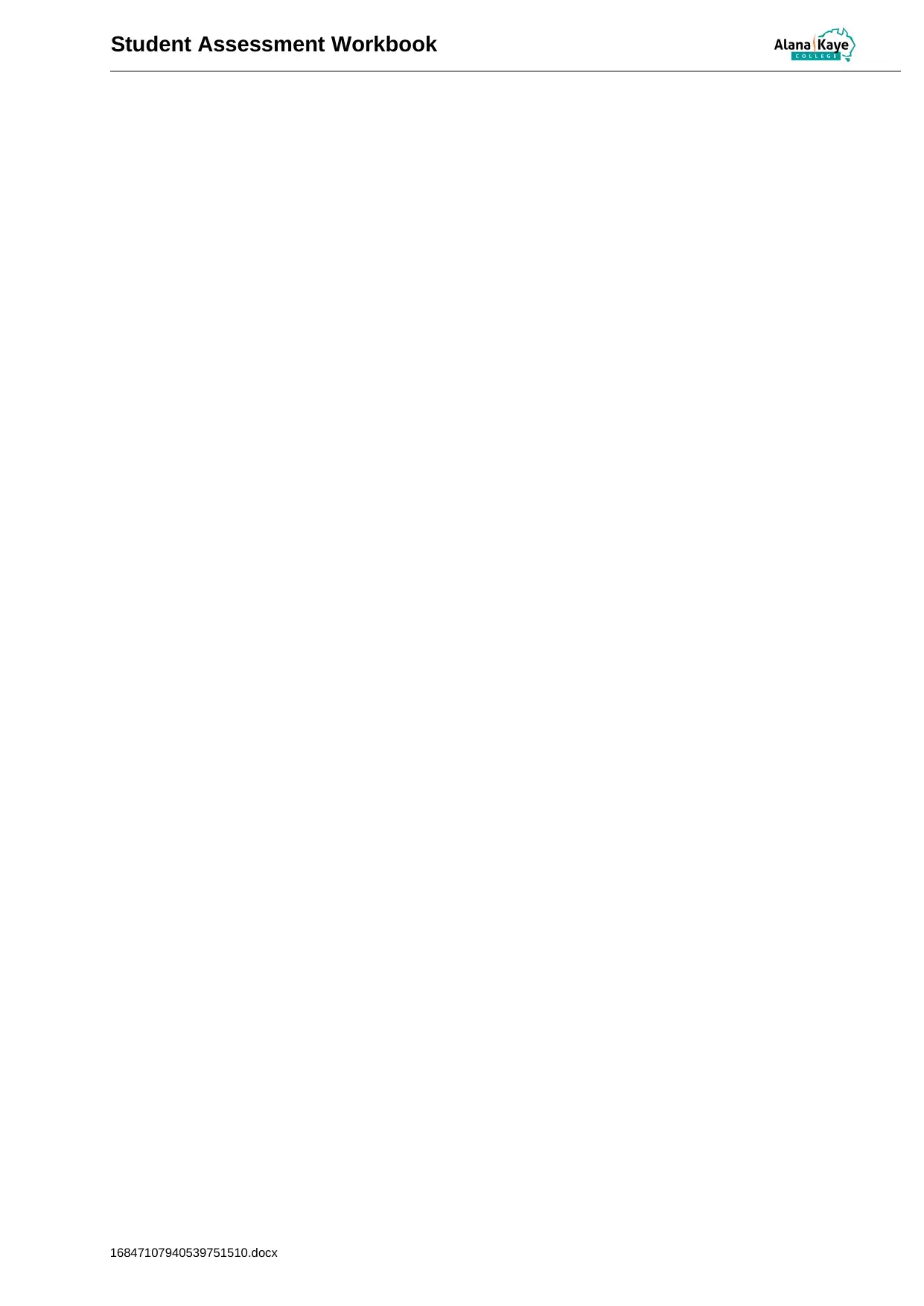
Student Assessment Workbook
16847107940539751510.docx
16847107940539751510.docx
Paraphrase This Document
Need a fresh take? Get an instant paraphrase of this document with our AI Paraphraser
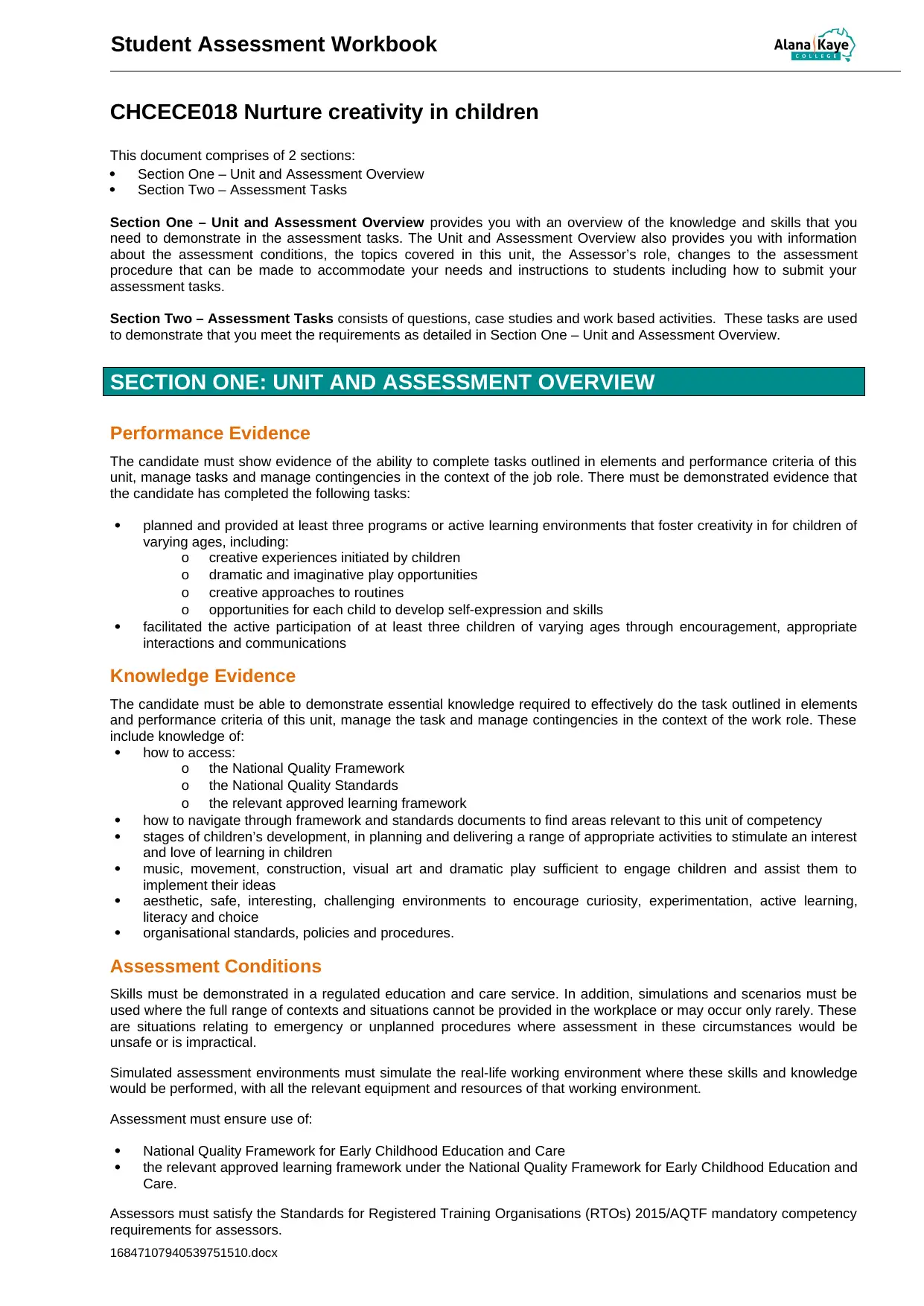
Student Assessment Workbook
CHCECE018 Nurture creativity in children
This document comprises of 2 sections:
Section One – Unit and Assessment Overview
Section Two – Assessment Tasks
Section One – Unit and Assessment Overview provides you with an overview of the knowledge and skills that you
need to demonstrate in the assessment tasks. The Unit and Assessment Overview also provides you with information
about the assessment conditions, the topics covered in this unit, the Assessor’s role, changes to the assessment
procedure that can be made to accommodate your needs and instructions to students including how to submit your
assessment tasks.
Section Two – Assessment Tasks consists of questions, case studies and work based activities. These tasks are used
to demonstrate that you meet the requirements as detailed in Section One – Unit and Assessment Overview.
SECTION ONE: UNIT AND ASSESSMENT OVERVIEW
Performance Evidence
The candidate must show evidence of the ability to complete tasks outlined in elements and performance criteria of this
unit, manage tasks and manage contingencies in the context of the job role. There must be demonstrated evidence that
the candidate has completed the following tasks:
planned and provided at least three programs or active learning environments that foster creativity in for children of
varying ages, including:
o creative experiences initiated by children
o dramatic and imaginative play opportunities
o creative approaches to routines
o opportunities for each child to develop self-expression and skills
facilitated the active participation of at least three children of varying ages through encouragement, appropriate
interactions and communications
Knowledge Evidence
The candidate must be able to demonstrate essential knowledge required to effectively do the task outlined in elements
and performance criteria of this unit, manage the task and manage contingencies in the context of the work role. These
include knowledge of:
how to access:
o the National Quality Framework
o the National Quality Standards
o the relevant approved learning framework
how to navigate through framework and standards documents to find areas relevant to this unit of competency
stages of children’s development, in planning and delivering a range of appropriate activities to stimulate an interest
and love of learning in children
music, movement, construction, visual art and dramatic play sufficient to engage children and assist them to
implement their ideas
aesthetic, safe, interesting, challenging environments to encourage curiosity, experimentation, active learning,
literacy and choice
organisational standards, policies and procedures.
Assessment Conditions
Skills must be demonstrated in a regulated education and care service. In addition, simulations and scenarios must be
used where the full range of contexts and situations cannot be provided in the workplace or may occur only rarely. These
are situations relating to emergency or unplanned procedures where assessment in these circumstances would be
unsafe or is impractical.
Simulated assessment environments must simulate the real-life working environment where these skills and knowledge
would be performed, with all the relevant equipment and resources of that working environment.
Assessment must ensure use of:
National Quality Framework for Early Childhood Education and Care
the relevant approved learning framework under the National Quality Framework for Early Childhood Education and
Care.
Assessors must satisfy the Standards for Registered Training Organisations (RTOs) 2015/AQTF mandatory competency
requirements for assessors.
16847107940539751510.docx
CHCECE018 Nurture creativity in children
This document comprises of 2 sections:
Section One – Unit and Assessment Overview
Section Two – Assessment Tasks
Section One – Unit and Assessment Overview provides you with an overview of the knowledge and skills that you
need to demonstrate in the assessment tasks. The Unit and Assessment Overview also provides you with information
about the assessment conditions, the topics covered in this unit, the Assessor’s role, changes to the assessment
procedure that can be made to accommodate your needs and instructions to students including how to submit your
assessment tasks.
Section Two – Assessment Tasks consists of questions, case studies and work based activities. These tasks are used
to demonstrate that you meet the requirements as detailed in Section One – Unit and Assessment Overview.
SECTION ONE: UNIT AND ASSESSMENT OVERVIEW
Performance Evidence
The candidate must show evidence of the ability to complete tasks outlined in elements and performance criteria of this
unit, manage tasks and manage contingencies in the context of the job role. There must be demonstrated evidence that
the candidate has completed the following tasks:
planned and provided at least three programs or active learning environments that foster creativity in for children of
varying ages, including:
o creative experiences initiated by children
o dramatic and imaginative play opportunities
o creative approaches to routines
o opportunities for each child to develop self-expression and skills
facilitated the active participation of at least three children of varying ages through encouragement, appropriate
interactions and communications
Knowledge Evidence
The candidate must be able to demonstrate essential knowledge required to effectively do the task outlined in elements
and performance criteria of this unit, manage the task and manage contingencies in the context of the work role. These
include knowledge of:
how to access:
o the National Quality Framework
o the National Quality Standards
o the relevant approved learning framework
how to navigate through framework and standards documents to find areas relevant to this unit of competency
stages of children’s development, in planning and delivering a range of appropriate activities to stimulate an interest
and love of learning in children
music, movement, construction, visual art and dramatic play sufficient to engage children and assist them to
implement their ideas
aesthetic, safe, interesting, challenging environments to encourage curiosity, experimentation, active learning,
literacy and choice
organisational standards, policies and procedures.
Assessment Conditions
Skills must be demonstrated in a regulated education and care service. In addition, simulations and scenarios must be
used where the full range of contexts and situations cannot be provided in the workplace or may occur only rarely. These
are situations relating to emergency or unplanned procedures where assessment in these circumstances would be
unsafe or is impractical.
Simulated assessment environments must simulate the real-life working environment where these skills and knowledge
would be performed, with all the relevant equipment and resources of that working environment.
Assessment must ensure use of:
National Quality Framework for Early Childhood Education and Care
the relevant approved learning framework under the National Quality Framework for Early Childhood Education and
Care.
Assessors must satisfy the Standards for Registered Training Organisations (RTOs) 2015/AQTF mandatory competency
requirements for assessors.
16847107940539751510.docx
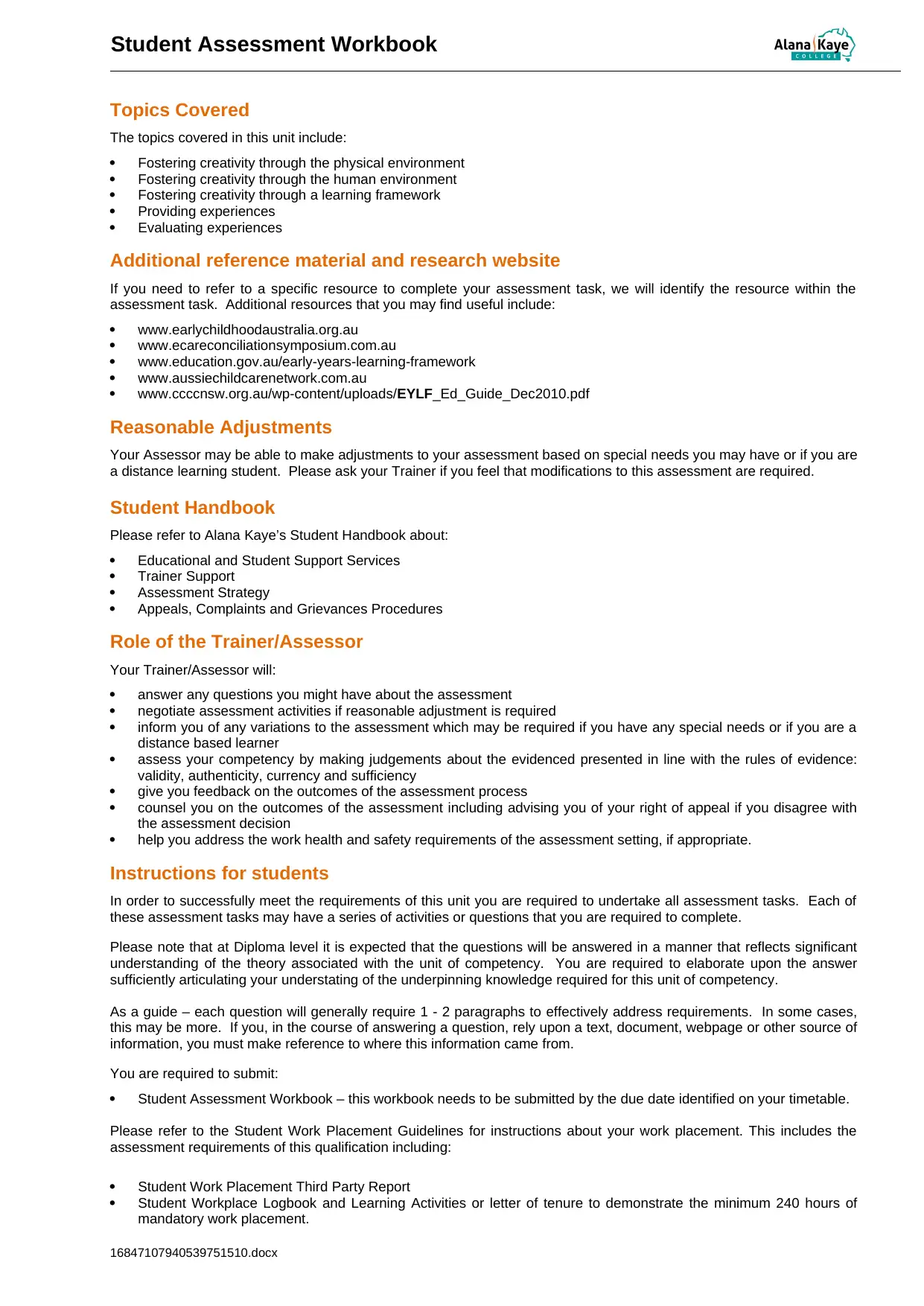
Student Assessment Workbook
Topics Covered
The topics covered in this unit include:
Fostering creativity through the physical environment
Fostering creativity through the human environment
Fostering creativity through a learning framework
Providing experiences
Evaluating experiences
Additional reference material and research website
If you need to refer to a specific resource to complete your assessment task, we will identify the resource within the
assessment task. Additional resources that you may find useful include:
www.earlychildhoodaustralia.org.au
www.ecareconciliationsymposium.com.au
www.education.gov.au/early-years-learning-framework
www.aussiechildcarenetwork.com.au
www.ccccnsw.org.au/wp-content/uploads/EYLF_Ed_Guide_Dec2010.pdf
Reasonable Adjustments
Your Assessor may be able to make adjustments to your assessment based on special needs you may have or if you are
a distance learning student. Please ask your Trainer if you feel that modifications to this assessment are required.
Student Handbook
Please refer to Alana Kaye’s Student Handbook about:
Educational and Student Support Services
Trainer Support
Assessment Strategy
Appeals, Complaints and Grievances Procedures
Role of the Trainer/Assessor
Your Trainer/Assessor will:
answer any questions you might have about the assessment
negotiate assessment activities if reasonable adjustment is required
inform you of any variations to the assessment which may be required if you have any special needs or if you are a
distance based learner
assess your competency by making judgements about the evidenced presented in line with the rules of evidence:
validity, authenticity, currency and sufficiency
give you feedback on the outcomes of the assessment process
counsel you on the outcomes of the assessment including advising you of your right of appeal if you disagree with
the assessment decision
help you address the work health and safety requirements of the assessment setting, if appropriate.
Instructions for students
In order to successfully meet the requirements of this unit you are required to undertake all assessment tasks. Each of
these assessment tasks may have a series of activities or questions that you are required to complete.
Please note that at Diploma level it is expected that the questions will be answered in a manner that reflects significant
understanding of the theory associated with the unit of competency. You are required to elaborate upon the answer
sufficiently articulating your understating of the underpinning knowledge required for this unit of competency.
As a guide – each question will generally require 1 - 2 paragraphs to effectively address requirements. In some cases,
this may be more. If you, in the course of answering a question, rely upon a text, document, webpage or other source of
information, you must make reference to where this information came from.
You are required to submit:
Student Assessment Workbook – this workbook needs to be submitted by the due date identified on your timetable.
Please refer to the Student Work Placement Guidelines for instructions about your work placement. This includes the
assessment requirements of this qualification including:
Student Work Placement Third Party Report
Student Workplace Logbook and Learning Activities or letter of tenure to demonstrate the minimum 240 hours of
mandatory work placement.
16847107940539751510.docx
Topics Covered
The topics covered in this unit include:
Fostering creativity through the physical environment
Fostering creativity through the human environment
Fostering creativity through a learning framework
Providing experiences
Evaluating experiences
Additional reference material and research website
If you need to refer to a specific resource to complete your assessment task, we will identify the resource within the
assessment task. Additional resources that you may find useful include:
www.earlychildhoodaustralia.org.au
www.ecareconciliationsymposium.com.au
www.education.gov.au/early-years-learning-framework
www.aussiechildcarenetwork.com.au
www.ccccnsw.org.au/wp-content/uploads/EYLF_Ed_Guide_Dec2010.pdf
Reasonable Adjustments
Your Assessor may be able to make adjustments to your assessment based on special needs you may have or if you are
a distance learning student. Please ask your Trainer if you feel that modifications to this assessment are required.
Student Handbook
Please refer to Alana Kaye’s Student Handbook about:
Educational and Student Support Services
Trainer Support
Assessment Strategy
Appeals, Complaints and Grievances Procedures
Role of the Trainer/Assessor
Your Trainer/Assessor will:
answer any questions you might have about the assessment
negotiate assessment activities if reasonable adjustment is required
inform you of any variations to the assessment which may be required if you have any special needs or if you are a
distance based learner
assess your competency by making judgements about the evidenced presented in line with the rules of evidence:
validity, authenticity, currency and sufficiency
give you feedback on the outcomes of the assessment process
counsel you on the outcomes of the assessment including advising you of your right of appeal if you disagree with
the assessment decision
help you address the work health and safety requirements of the assessment setting, if appropriate.
Instructions for students
In order to successfully meet the requirements of this unit you are required to undertake all assessment tasks. Each of
these assessment tasks may have a series of activities or questions that you are required to complete.
Please note that at Diploma level it is expected that the questions will be answered in a manner that reflects significant
understanding of the theory associated with the unit of competency. You are required to elaborate upon the answer
sufficiently articulating your understating of the underpinning knowledge required for this unit of competency.
As a guide – each question will generally require 1 - 2 paragraphs to effectively address requirements. In some cases,
this may be more. If you, in the course of answering a question, rely upon a text, document, webpage or other source of
information, you must make reference to where this information came from.
You are required to submit:
Student Assessment Workbook – this workbook needs to be submitted by the due date identified on your timetable.
Please refer to the Student Work Placement Guidelines for instructions about your work placement. This includes the
assessment requirements of this qualification including:
Student Work Placement Third Party Report
Student Workplace Logbook and Learning Activities or letter of tenure to demonstrate the minimum 240 hours of
mandatory work placement.
16847107940539751510.docx
⊘ This is a preview!⊘
Do you want full access?
Subscribe today to unlock all pages.

Trusted by 1+ million students worldwide
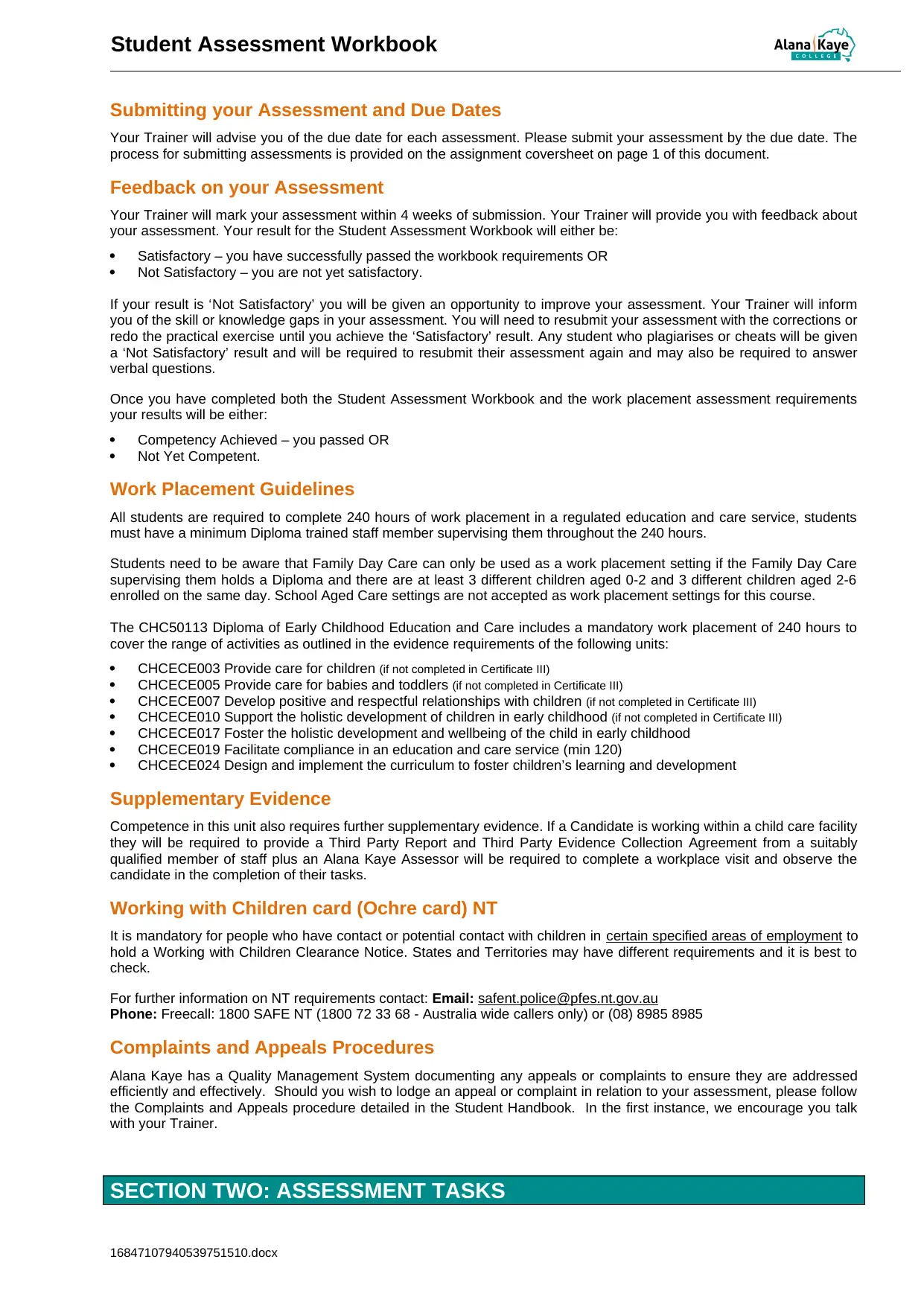
Student Assessment Workbook
Submitting your Assessment and Due Dates
Your Trainer will advise you of the due date for each assessment. Please submit your assessment by the due date. The
process for submitting assessments is provided on the assignment coversheet on page 1 of this document.
Feedback on your Assessment
Your Trainer will mark your assessment within 4 weeks of submission. Your Trainer will provide you with feedback about
your assessment. Your result for the Student Assessment Workbook will either be:
Satisfactory – you have successfully passed the workbook requirements OR
Not Satisfactory – you are not yet satisfactory.
If your result is ‘Not Satisfactory’ you will be given an opportunity to improve your assessment. Your Trainer will inform
you of the skill or knowledge gaps in your assessment. You will need to resubmit your assessment with the corrections or
redo the practical exercise until you achieve the ‘Satisfactory’ result. Any student who plagiarises or cheats will be given
a ‘Not Satisfactory’ result and will be required to resubmit their assessment again and may also be required to answer
verbal questions.
Once you have completed both the Student Assessment Workbook and the work placement assessment requirements
your results will be either:
Competency Achieved – you passed OR
Not Yet Competent.
Work Placement Guidelines
All students are required to complete 240 hours of work placement in a regulated education and care service, students
must have a minimum Diploma trained staff member supervising them throughout the 240 hours.
Students need to be aware that Family Day Care can only be used as a work placement setting if the Family Day Care
supervising them holds a Diploma and there are at least 3 different children aged 0-2 and 3 different children aged 2-6
enrolled on the same day. School Aged Care settings are not accepted as work placement settings for this course.
The CHC50113 Diploma of Early Childhood Education and Care includes a mandatory work placement of 240 hours to
cover the range of activities as outlined in the evidence requirements of the following units:
CHCECE003 Provide care for children (if not completed in Certificate III)
CHCECE005 Provide care for babies and toddlers (if not completed in Certificate III)
CHCECE007 Develop positive and respectful relationships with children (if not completed in Certificate III)
CHCECE010 Support the holistic development of children in early childhood (if not completed in Certificate III)
CHCECE017 Foster the holistic development and wellbeing of the child in early childhood
CHCECE019 Facilitate compliance in an education and care service (min 120)
CHCECE024 Design and implement the curriculum to foster children’s learning and development
Supplementary Evidence
Competence in this unit also requires further supplementary evidence. If a Candidate is working within a child care facility
they will be required to provide a Third Party Report and Third Party Evidence Collection Agreement from a suitably
qualified member of staff plus an Alana Kaye Assessor will be required to complete a workplace visit and observe the
candidate in the completion of their tasks.
Working with Children card (Ochre card) NT
It is mandatory for people who have contact or potential contact with children in certain specified areas of employment to
hold a Working with Children Clearance Notice. States and Territories may have different requirements and it is best to
check.
For further information on NT requirements contact: Email: safent.police@pfes.nt.gov.au
Phone: Freecall: 1800 SAFE NT (1800 72 33 68 - Australia wide callers only) or (08) 8985 8985
Complaints and Appeals Procedures
Alana Kaye has a Quality Management System documenting any appeals or complaints to ensure they are addressed
efficiently and effectively. Should you wish to lodge an appeal or complaint in relation to your assessment, please follow
the Complaints and Appeals procedure detailed in the Student Handbook. In the first instance, we encourage you talk
with your Trainer.
SECTION TWO: ASSESSMENT TASKS
16847107940539751510.docx
Submitting your Assessment and Due Dates
Your Trainer will advise you of the due date for each assessment. Please submit your assessment by the due date. The
process for submitting assessments is provided on the assignment coversheet on page 1 of this document.
Feedback on your Assessment
Your Trainer will mark your assessment within 4 weeks of submission. Your Trainer will provide you with feedback about
your assessment. Your result for the Student Assessment Workbook will either be:
Satisfactory – you have successfully passed the workbook requirements OR
Not Satisfactory – you are not yet satisfactory.
If your result is ‘Not Satisfactory’ you will be given an opportunity to improve your assessment. Your Trainer will inform
you of the skill or knowledge gaps in your assessment. You will need to resubmit your assessment with the corrections or
redo the practical exercise until you achieve the ‘Satisfactory’ result. Any student who plagiarises or cheats will be given
a ‘Not Satisfactory’ result and will be required to resubmit their assessment again and may also be required to answer
verbal questions.
Once you have completed both the Student Assessment Workbook and the work placement assessment requirements
your results will be either:
Competency Achieved – you passed OR
Not Yet Competent.
Work Placement Guidelines
All students are required to complete 240 hours of work placement in a regulated education and care service, students
must have a minimum Diploma trained staff member supervising them throughout the 240 hours.
Students need to be aware that Family Day Care can only be used as a work placement setting if the Family Day Care
supervising them holds a Diploma and there are at least 3 different children aged 0-2 and 3 different children aged 2-6
enrolled on the same day. School Aged Care settings are not accepted as work placement settings for this course.
The CHC50113 Diploma of Early Childhood Education and Care includes a mandatory work placement of 240 hours to
cover the range of activities as outlined in the evidence requirements of the following units:
CHCECE003 Provide care for children (if not completed in Certificate III)
CHCECE005 Provide care for babies and toddlers (if not completed in Certificate III)
CHCECE007 Develop positive and respectful relationships with children (if not completed in Certificate III)
CHCECE010 Support the holistic development of children in early childhood (if not completed in Certificate III)
CHCECE017 Foster the holistic development and wellbeing of the child in early childhood
CHCECE019 Facilitate compliance in an education and care service (min 120)
CHCECE024 Design and implement the curriculum to foster children’s learning and development
Supplementary Evidence
Competence in this unit also requires further supplementary evidence. If a Candidate is working within a child care facility
they will be required to provide a Third Party Report and Third Party Evidence Collection Agreement from a suitably
qualified member of staff plus an Alana Kaye Assessor will be required to complete a workplace visit and observe the
candidate in the completion of their tasks.
Working with Children card (Ochre card) NT
It is mandatory for people who have contact or potential contact with children in certain specified areas of employment to
hold a Working with Children Clearance Notice. States and Territories may have different requirements and it is best to
check.
For further information on NT requirements contact: Email: safent.police@pfes.nt.gov.au
Phone: Freecall: 1800 SAFE NT (1800 72 33 68 - Australia wide callers only) or (08) 8985 8985
Complaints and Appeals Procedures
Alana Kaye has a Quality Management System documenting any appeals or complaints to ensure they are addressed
efficiently and effectively. Should you wish to lodge an appeal or complaint in relation to your assessment, please follow
the Complaints and Appeals procedure detailed in the Student Handbook. In the first instance, we encourage you talk
with your Trainer.
SECTION TWO: ASSESSMENT TASKS
16847107940539751510.docx
Paraphrase This Document
Need a fresh take? Get an instant paraphrase of this document with our AI Paraphraser
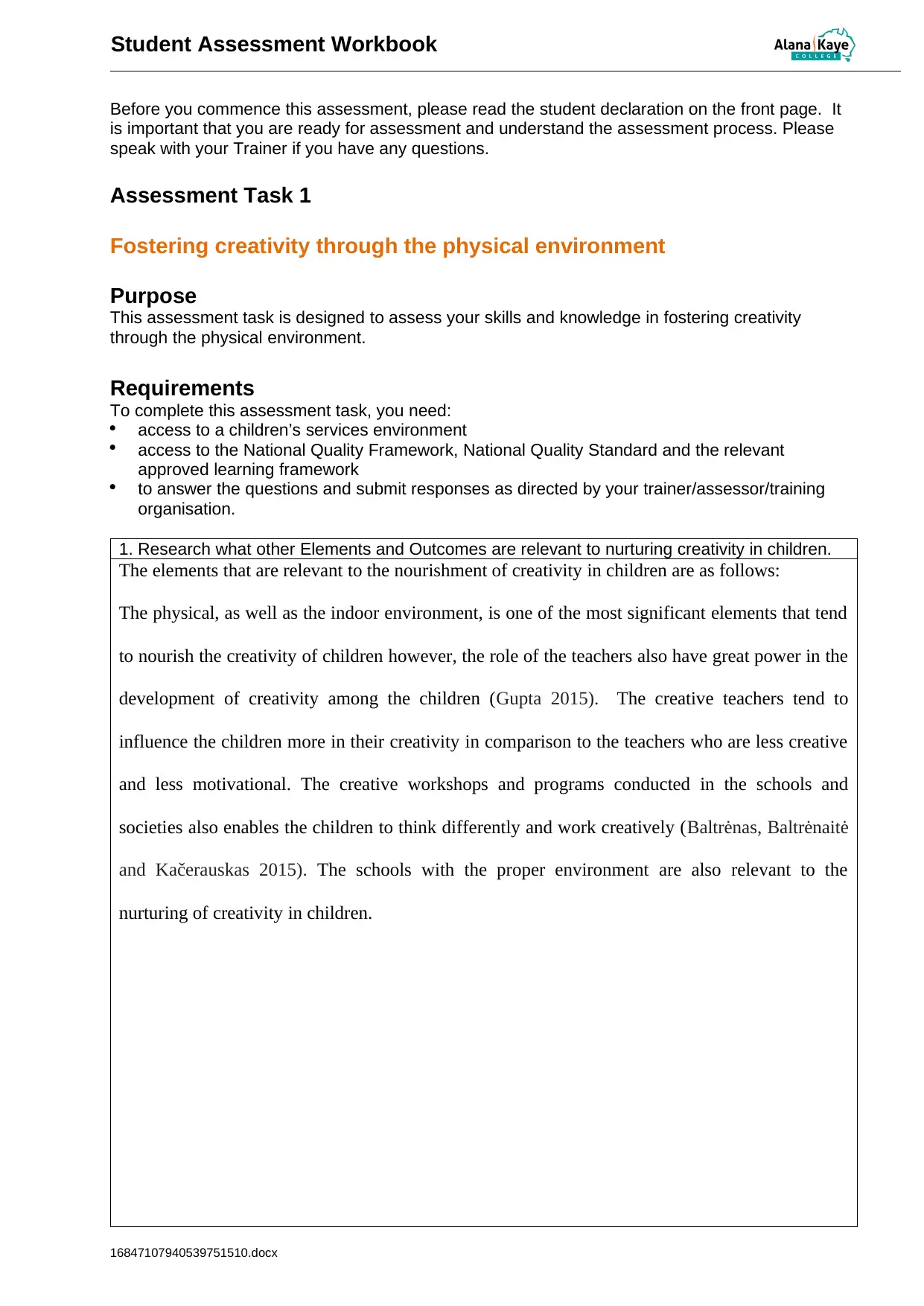
Student Assessment Workbook
Before you commence this assessment, please read the student declaration on the front page. It
is important that you are ready for assessment and understand the assessment process. Please
speak with your Trainer if you have any questions.
Assessment Task 1
Fostering creativity through the physical environment
Purpose
This assessment task is designed to assess your skills and knowledge in fostering creativity
through the physical environment.
Requirements
To complete this assessment task, you need:
access to a children’s services environment
access to the National Quality Framework, National Quality Standard and the relevant
approved learning framework
to answer the questions and submit responses as directed by your trainer/assessor/training
organisation.
1. Research what other Elements and Outcomes are relevant to nurturing creativity in children.
The elements that are relevant to the nourishment of creativity in children are as follows:
The physical, as well as the indoor environment, is one of the most significant elements that tend
to nourish the creativity of children however, the role of the teachers also have great power in the
development of creativity among the children (Gupta 2015). The creative teachers tend to
influence the children more in their creativity in comparison to the teachers who are less creative
and less motivational. The creative workshops and programs conducted in the schools and
societies also enables the children to think differently and work creatively (Baltrėnas, Baltrėnaitė
and Kačerauskas 2015). The schools with the proper environment are also relevant to the
nurturing of creativity in children.
16847107940539751510.docx
Before you commence this assessment, please read the student declaration on the front page. It
is important that you are ready for assessment and understand the assessment process. Please
speak with your Trainer if you have any questions.
Assessment Task 1
Fostering creativity through the physical environment
Purpose
This assessment task is designed to assess your skills and knowledge in fostering creativity
through the physical environment.
Requirements
To complete this assessment task, you need:
access to a children’s services environment
access to the National Quality Framework, National Quality Standard and the relevant
approved learning framework
to answer the questions and submit responses as directed by your trainer/assessor/training
organisation.
1. Research what other Elements and Outcomes are relevant to nurturing creativity in children.
The elements that are relevant to the nourishment of creativity in children are as follows:
The physical, as well as the indoor environment, is one of the most significant elements that tend
to nourish the creativity of children however, the role of the teachers also have great power in the
development of creativity among the children (Gupta 2015). The creative teachers tend to
influence the children more in their creativity in comparison to the teachers who are less creative
and less motivational. The creative workshops and programs conducted in the schools and
societies also enables the children to think differently and work creatively (Baltrėnas, Baltrėnaitė
and Kačerauskas 2015). The schools with the proper environment are also relevant to the
nurturing of creativity in children.
16847107940539751510.docx
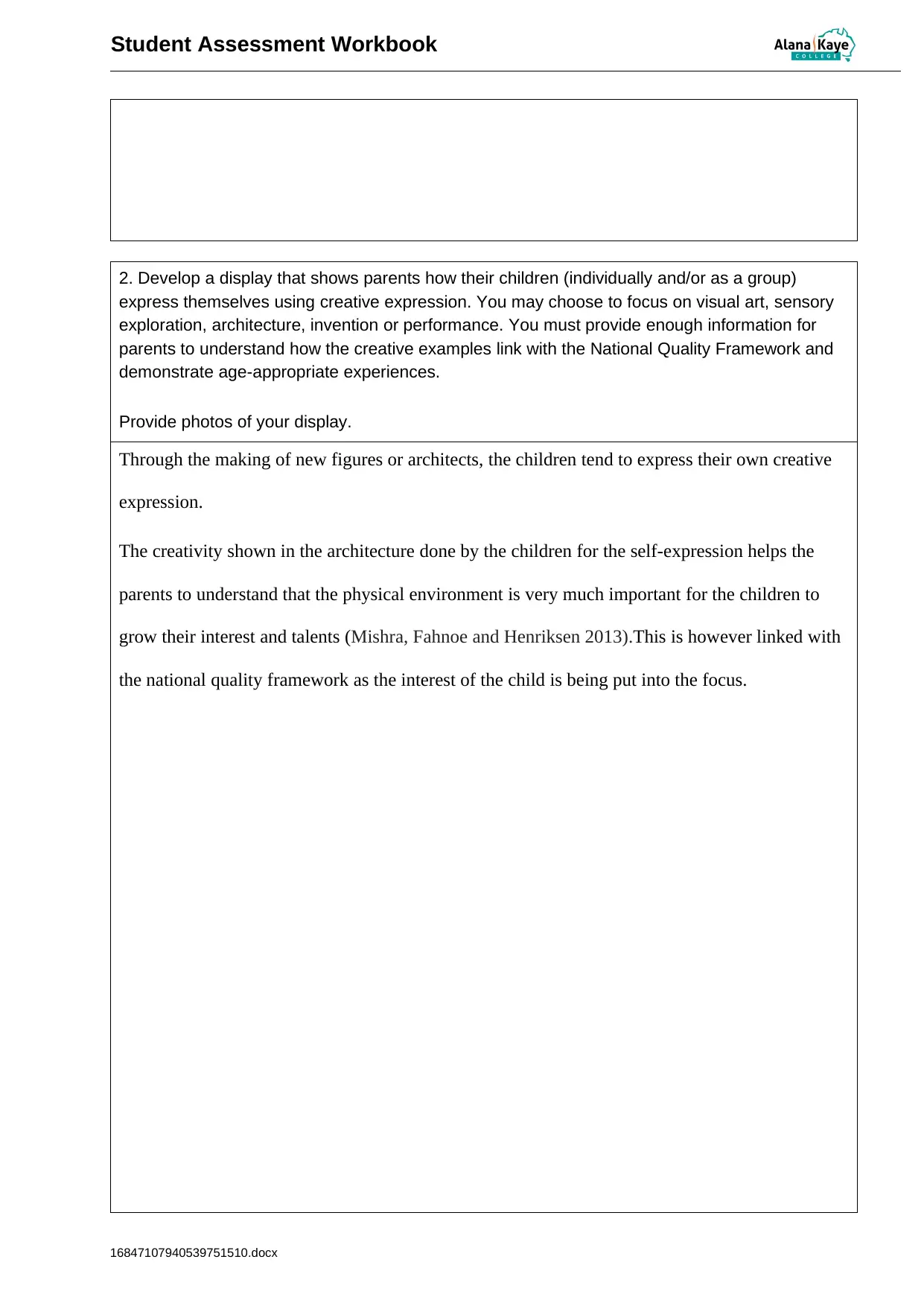
Student Assessment Workbook
2. Develop a display that shows parents how their children (individually and/or as a group)
express themselves using creative expression. You may choose to focus on visual art, sensory
exploration, architecture, invention or performance. You must provide enough information for
parents to understand how the creative examples link with the National Quality Framework and
demonstrate age-appropriate experiences.
Provide photos of your display.
Through the making of new figures or architects, the children tend to express their own creative
expression.
The creativity shown in the architecture done by the children for the self-expression helps the
parents to understand that the physical environment is very much important for the children to
grow their interest and talents (Mishra, Fahnoe and Henriksen 2013).This is however linked with
the national quality framework as the interest of the child is being put into the focus.
16847107940539751510.docx
2. Develop a display that shows parents how their children (individually and/or as a group)
express themselves using creative expression. You may choose to focus on visual art, sensory
exploration, architecture, invention or performance. You must provide enough information for
parents to understand how the creative examples link with the National Quality Framework and
demonstrate age-appropriate experiences.
Provide photos of your display.
Through the making of new figures or architects, the children tend to express their own creative
expression.
The creativity shown in the architecture done by the children for the self-expression helps the
parents to understand that the physical environment is very much important for the children to
grow their interest and talents (Mishra, Fahnoe and Henriksen 2013).This is however linked with
the national quality framework as the interest of the child is being put into the focus.
16847107940539751510.docx
⊘ This is a preview!⊘
Do you want full access?
Subscribe today to unlock all pages.

Trusted by 1+ million students worldwide
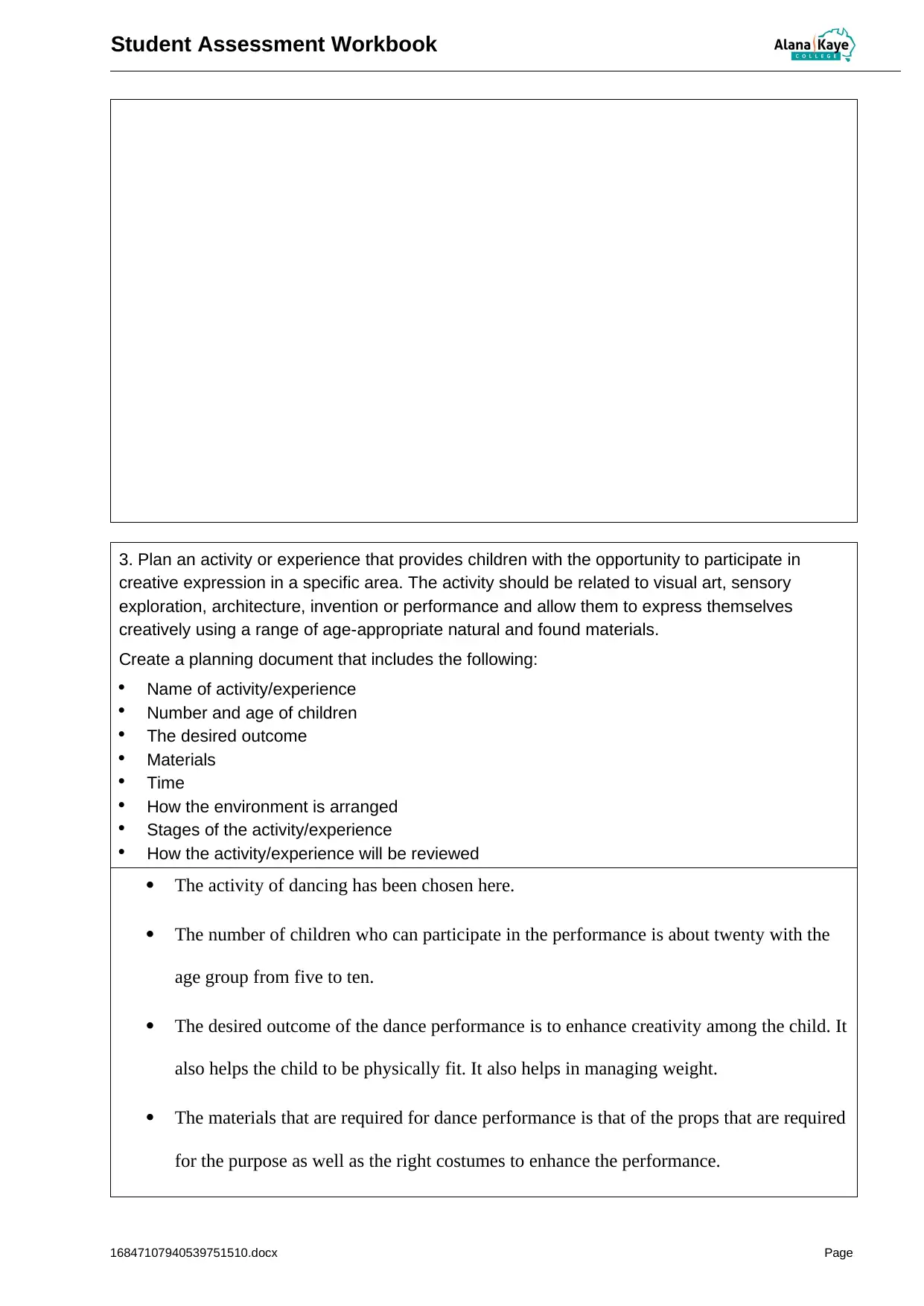
Student Assessment Workbook
3. Plan an activity or experience that provides children with the opportunity to participate in
creative expression in a specific area. The activity should be related to visual art, sensory
exploration, architecture, invention or performance and allow them to express themselves
creatively using a range of age-appropriate natural and found materials.
Create a planning document that includes the following:
Name of activity/experience
Number and age of children
The desired outcome
Materials
Time
How the environment is arranged
Stages of the activity/experience
How the activity/experience will be reviewed
The activity of dancing has been chosen here.
The number of children who can participate in the performance is about twenty with the
age group from five to ten.
The desired outcome of the dance performance is to enhance creativity among the child. It
also helps the child to be physically fit. It also helps in managing weight.
The materials that are required for dance performance is that of the props that are required
for the purpose as well as the right costumes to enhance the performance.
16847107940539751510.docx Page
3. Plan an activity or experience that provides children with the opportunity to participate in
creative expression in a specific area. The activity should be related to visual art, sensory
exploration, architecture, invention or performance and allow them to express themselves
creatively using a range of age-appropriate natural and found materials.
Create a planning document that includes the following:
Name of activity/experience
Number and age of children
The desired outcome
Materials
Time
How the environment is arranged
Stages of the activity/experience
How the activity/experience will be reviewed
The activity of dancing has been chosen here.
The number of children who can participate in the performance is about twenty with the
age group from five to ten.
The desired outcome of the dance performance is to enhance creativity among the child. It
also helps the child to be physically fit. It also helps in managing weight.
The materials that are required for dance performance is that of the props that are required
for the purpose as well as the right costumes to enhance the performance.
16847107940539751510.docx Page
Paraphrase This Document
Need a fresh take? Get an instant paraphrase of this document with our AI Paraphraser
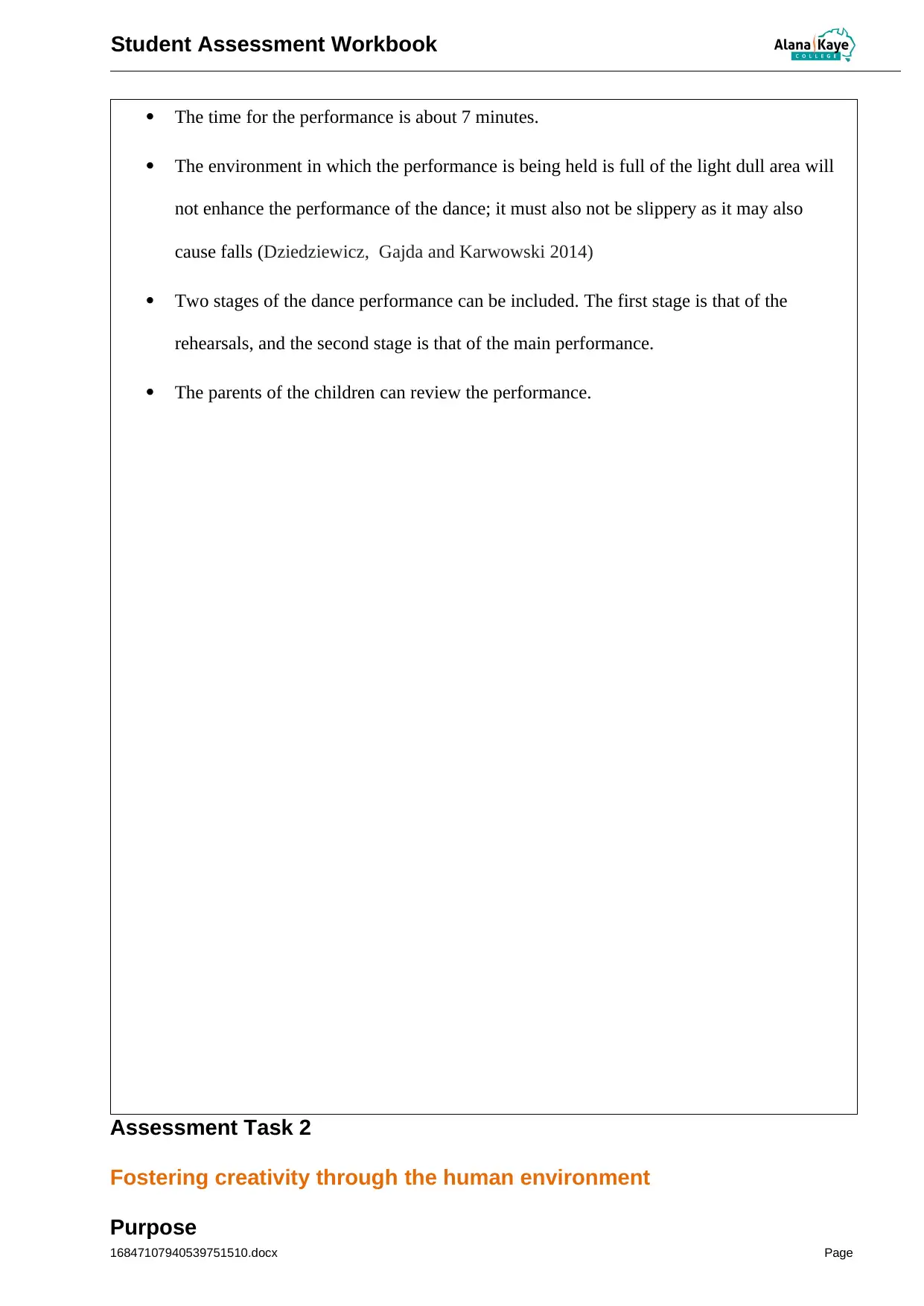
Student Assessment Workbook
The time for the performance is about 7 minutes.
The environment in which the performance is being held is full of the light dull area will
not enhance the performance of the dance; it must also not be slippery as it may also
cause falls (Dziedziewicz, Gajda and Karwowski 2014)
Two stages of the dance performance can be included. The first stage is that of the
rehearsals, and the second stage is that of the main performance.
The parents of the children can review the performance.
Assessment Task 2
Fostering creativity through the human environment
Purpose
16847107940539751510.docx Page
The time for the performance is about 7 minutes.
The environment in which the performance is being held is full of the light dull area will
not enhance the performance of the dance; it must also not be slippery as it may also
cause falls (Dziedziewicz, Gajda and Karwowski 2014)
Two stages of the dance performance can be included. The first stage is that of the
rehearsals, and the second stage is that of the main performance.
The parents of the children can review the performance.
Assessment Task 2
Fostering creativity through the human environment
Purpose
16847107940539751510.docx Page
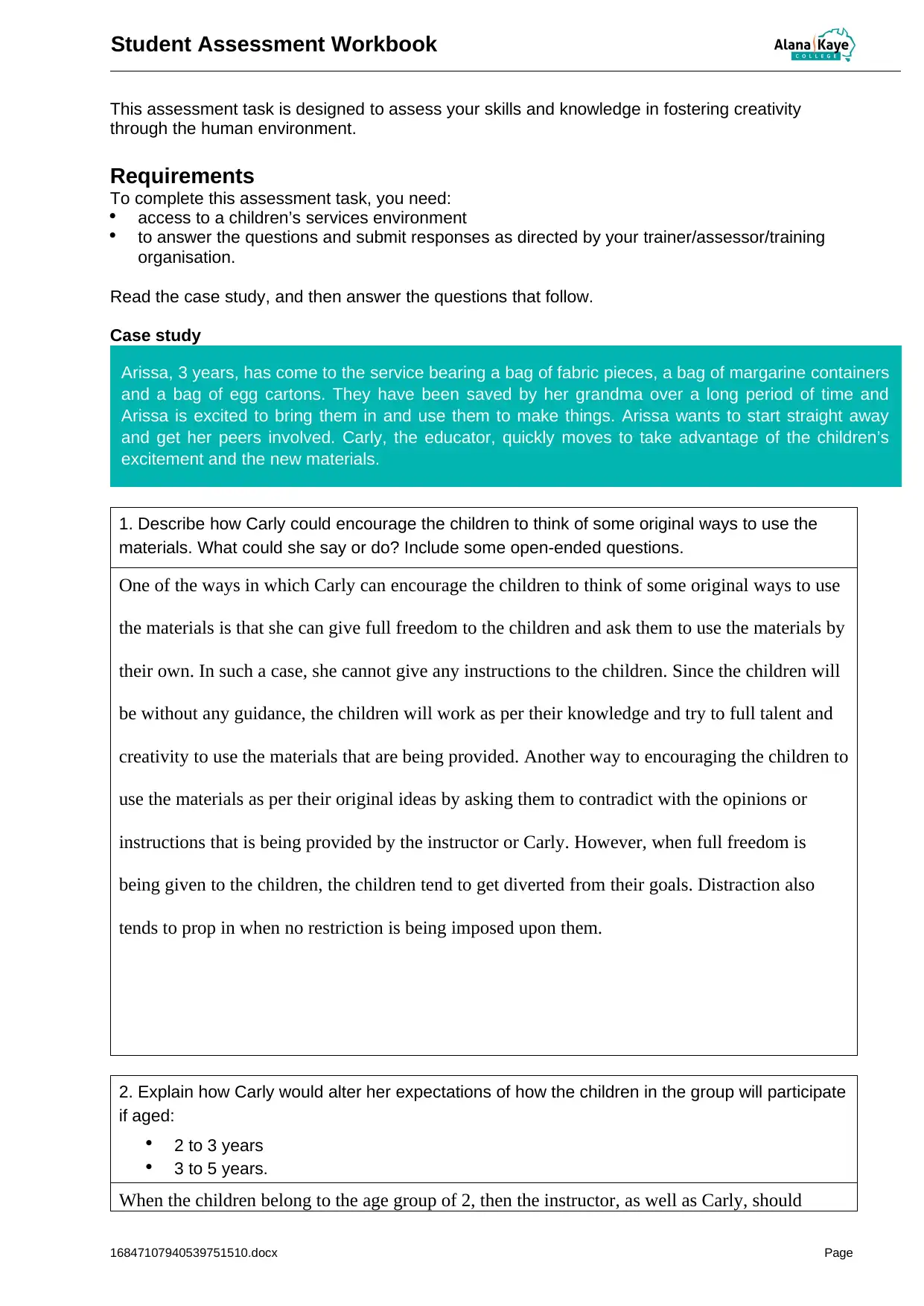
Student Assessment Workbook
This assessment task is designed to assess your skills and knowledge in fostering creativity
through the human environment.
Requirements
To complete this assessment task, you need:
access to a children’s services environment
to answer the questions and submit responses as directed by your trainer/assessor/training
organisation.
Read the case study, and then answer the questions that follow.
Case study
Arissa, 3 years, has come to the service bearing a bag of fabric pieces, a bag of margarine containers
and a bag of egg cartons. They have been saved by her grandma over a long period of time and
Arissa is excited to bring them in and use them to make things. Arissa wants to start straight away
and get her peers involved. Carly, the educator, quickly moves to take advantage of the children’s
excitement and the new materials.
1. Describe how Carly could encourage the children to think of some original ways to use the
materials. What could she say or do? Include some open-ended questions.
One of the ways in which Carly can encourage the children to think of some original ways to use
the materials is that she can give full freedom to the children and ask them to use the materials by
their own. In such a case, she cannot give any instructions to the children. Since the children will
be without any guidance, the children will work as per their knowledge and try to full talent and
creativity to use the materials that are being provided. Another way to encouraging the children to
use the materials as per their original ideas by asking them to contradict with the opinions or
instructions that is being provided by the instructor or Carly. However, when full freedom is
being given to the children, the children tend to get diverted from their goals. Distraction also
tends to prop in when no restriction is being imposed upon them.
2. Explain how Carly would alter her expectations of how the children in the group will participate
if aged:
2 to 3 years
3 to 5 years.
When the children belong to the age group of 2, then the instructor, as well as Carly, should
16847107940539751510.docx Page
This assessment task is designed to assess your skills and knowledge in fostering creativity
through the human environment.
Requirements
To complete this assessment task, you need:
access to a children’s services environment
to answer the questions and submit responses as directed by your trainer/assessor/training
organisation.
Read the case study, and then answer the questions that follow.
Case study
Arissa, 3 years, has come to the service bearing a bag of fabric pieces, a bag of margarine containers
and a bag of egg cartons. They have been saved by her grandma over a long period of time and
Arissa is excited to bring them in and use them to make things. Arissa wants to start straight away
and get her peers involved. Carly, the educator, quickly moves to take advantage of the children’s
excitement and the new materials.
1. Describe how Carly could encourage the children to think of some original ways to use the
materials. What could she say or do? Include some open-ended questions.
One of the ways in which Carly can encourage the children to think of some original ways to use
the materials is that she can give full freedom to the children and ask them to use the materials by
their own. In such a case, she cannot give any instructions to the children. Since the children will
be without any guidance, the children will work as per their knowledge and try to full talent and
creativity to use the materials that are being provided. Another way to encouraging the children to
use the materials as per their original ideas by asking them to contradict with the opinions or
instructions that is being provided by the instructor or Carly. However, when full freedom is
being given to the children, the children tend to get diverted from their goals. Distraction also
tends to prop in when no restriction is being imposed upon them.
2. Explain how Carly would alter her expectations of how the children in the group will participate
if aged:
2 to 3 years
3 to 5 years.
When the children belong to the age group of 2, then the instructor, as well as Carly, should
16847107940539751510.docx Page
⊘ This is a preview!⊘
Do you want full access?
Subscribe today to unlock all pages.

Trusted by 1+ million students worldwide
1 out of 42
Related Documents
Your All-in-One AI-Powered Toolkit for Academic Success.
+13062052269
info@desklib.com
Available 24*7 on WhatsApp / Email
![[object Object]](/_next/static/media/star-bottom.7253800d.svg)
Unlock your academic potential
Copyright © 2020–2025 A2Z Services. All Rights Reserved. Developed and managed by ZUCOL.





